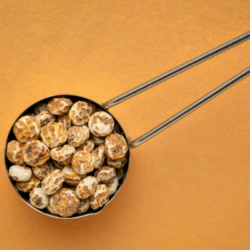Brown adipose tissue is a type of adipose tissue that burns fat to produce heat and maintain body temperature. Unlike white adipose tissue, brown adipose tissue is rich in mitochondria and blood capillaries, enabling it to burn more fat. In this article, we will discuss how to develop your brown adipose tissue.
Understanding brown adipose tissue
Adipose tissue is a type of connective tissue that specialises in storing energy in the form of fat. We have 2 types of adipose tissue: white adipose tissue and brown adipose tissue. While white fat is associated with the development of metabolic and cardiovascular disorders if it is present in excess, brown fat is extremely important for our metabolic health, particularly as it contains a large number of mitochondria to produce heat. Living in an overheated environment encourages the decline of brown adipose tissue, because thermogenesis is not sufficiently stimulated.
This adipose tissue is present in greater quantities in newborns and decreases with age. However, it can be developed in adults by adopting certain habits.
How brown adipose tissue works
This tissue is capable of burning fat to produce heat thanks to a specific protein called UCP-1 (uncoupling protein 1). This protein enables energy to be dissipated in the form of heat rather than stored as fat.
To carry out its physiological functions, the body needs to maintain an internal temperature of around 37°C, whatever the external temperature. Between 22 and 25°C, the body fights neither against heat (thermolysis) nor against cold (thermogenesis); it is in a state of thermal neutrality, a mechanism known as thermoregulation.
- During thermolysis: There is vasodilation of the skin, sweating and urinary retention to evacuate the heat.
- During thermogenesis: there is vasoconstriction of the skin, shivering and urine loss to conserve heat.
The energy expended during thermogenesis is greater than that expended during thermolysis.
Difference between brown and white adipose tissue
White adipose tissue stores energy in the form of fat, while brown adipose tissue burns fat to produce heat. White adipose tissue is more prevalent in adults and can lead to obesity if it is in excess.
- Function:
- Brown adipose tissue is mainly responsible for thermogenesis, i.e. the production of heat by the body, particularly in newborns and hibernating animals.
- white adipose tissue’s main function is to store energy in the form of triglycerides and also acts as a thermal insulator and protective cushion for the internal organs.
- Colour and appearance :
- Brown adipose tissue: As its name suggests, it is brown in colour due to the presence of numerous mitochondria and a high blood supply.
- White adipose tissue: This is white or yellowish in colour due to the low density of mitochondria and the large quantity of stored lipids.
- Cells :
- Brown adipose tissue cells, called brown adipocytes, contain several small lipid droplets and a large number of mitochondria, which give them their characteristic colour.
- White adipose tissue cells, known as white adipocytes, contain a single large lipid droplet which occupies most of the cell and a reduced number of mitochondria.
- Distribution in the body :
- Brown adipose tissue: Found mainly around the neck, collarbone and along the spine in humans. In newborns, it is also abundant around the internal organs.
- White adipose tissue: This is distributed throughout the body and is found mainly under the skin (subcutaneous fat) and around the internal organs (visceral fat).
What is the thermogenic and metabolic role of brown adipose tissue?
Brown adipose tissue generates heat by burning calories, a process known as non-shivering thermogenesis. This ability to burn excess fats and sugars could be beneficial in the treatment of obesity and diabetes. Increased activity of brown adipose tissue is associated with improved insulin sensitivity and reduced body fat.
Impact on obesity
Obesity results from an imbalance between calorie intake and energy expenditure. Brown adipose tissue, with its high thermogenic potential, can increase energy expenditure. This suggests that activating or increasing brown adipose tissue could help control weight and combat obesity.
Influence on diabetes
Diabetes, particularly type 2 diabetes, is often linked to obesity and insulin resistance. Brown adipose tissue improves insulin sensitivity and blood sugar regulation by burning excess glucose. It could therefore play a role in preventing or managing diabetes.
Therapeutic prospects
Recognising the importance of brown adipose tissue in metabolic regulation, researchers are exploring strategies to stimulate its activity. These strategies include lifestyle modifications, such as exposure to cold, and the development of drugs targeting the metabolic pathways of brown adipose tissue.
How is brown adipose tissue developed?
The development of brown tissue can be stimulated by various methods. Here are some of them:
1. Exposure to cold
Exposure to cold is one of the most effective ways of activating and developing brown adipose tissue. When the body is exposed to low temperatures, it reacts by activating brown adipose tissue to produce heat, a process known as thermogenesis. Methods such as taking cold showers, swimming in cold water, or spending time outdoors during the winter can stimulate this activation. Cold induces an increase in thermogenesis in brown adipose tissue, which can lead to an increase in energy expenditure and an improvement in insulin sensitivity.
2. Exercise
Regular physical exercise is also an effective method of stimulating brown adipose tissue. Cardiovascular activities such as running, swimming or cycling increase body temperature and energy expenditure, which can stimulate brown fat tissue. Exercise not only promotes weight loss by burning calories, but can also activate brown adipose tissue, improving metabolism and overall health.
3. Sleep
Lack of sleep can have a negative impact on health and weight loss. Quality sleep can help regulate body temperature and stimulate brown adipose tissue to burn more fat.
4. Diet and nutrition
Foods rich in omega-3 fatty acids such as oily fish, nuts and seeds can help increase brown fat tissue.
5. Drinking green tea
Consumption of green tea for the development of brown adipose tissue is based on the unique properties of its constituents, principally catechins. These natural antioxidants have beneficial effects on metabolism and body weight management.
Catechins, which are present in large quantities in green tea, are known for their ability to stimulate the metabolism. They can increase energy expenditure and promote fat oxidation. This thermogenic action is particularly useful for activating brown adipose tissue, known for its ability to burn calories in the form of heat. Drinking green tea regularly can potentially stimulate the development and activity of brown adipose tissue. This is due to the effect of catechins which, by increasing energy expenditure and promoting lipolysis (the breakdown of lipids), can activate brown adipose tissue cells.
6. Meditation
Meditation can help reduce stress and anxiety, which can have a negative impact on metabolism and general health. One study has shown that regular meditation can stimulate the development of brown adipose tissue.
7. Avoid tobacco and alcohol
Smoking and alcohol can have a negative impact on health and weight loss. Smoking can reduce the body’s ability to burn fat, while drinking alcohol can increase calorie intake and reduce metabolism.
8. Limit sugar consumption
Excessive sugar consumption can contribute to weight gain and obesity. Sugar-rich foods can also reduce the body’s ability to burn fat. Limiting sugar intake can help to stimulate the development of brown adipose tissue.
A healthier lifestyle every day
The development of this fatty tissue can be stimulated by various methods, such as exposure to cold, exercise, sleep, diet, drinking green tea, meditation, avoiding tobacco and alcohol, and limiting sugar consumption. By adopting these habits, you can increase the amount of brown tissue in your body and improve your overall health.
What impact do stress and anxiety have on brown tissue?
The impact of stress and anxiety on this fatty tissue is an area of research that has become increasingly important in recent years. Studies indicate that stress can have various effects on the metabolic functioning of this tissue.
One study explored how exposure to acute stress, such as crowding stress, affects the metabolic function of brown adipose tissue in rats. The results indicated that stress did not alter monoamine oxidase (MAO) activity in the hypothalamus and brown adipose tissue. However, after a recovery period, changes were observed in antioxidant enzyme activities, suggesting a reactivation of thermogenesis in brown adipose tissue.
Other research has shown that physical exercise, often combined with stress management, stimulates the development of tan adipose tissue and may influence the function of brown adipose tissue (BAT). This tissue is known to contribute to metabolic balance through non-shivering thermogenesis and may offer protection against oxidative stress. Exercise-related balance of ROS (reactive oxygen species) levels is associated with healthy metabolism in humans.
These studies suggest that stress, depending on its nature and management, can have complex effects on adipose tissue. The response of this adipose tissue to stress could therefore depend on a number of factors, including the nature of the stress (psychosocial or physical) and the presence of other modulating factors such as physical exercise.
FAQ
- Can brown adipose tissue help with weight loss? Yes, it can help burn fat and increase metabolism, which can contribute to weight loss.
- Is it possible to develop brown adipose tissue at any age? Yes, it can be developed in adults by adopting certain habits.
- What foods can stimulate the development of brown adipose tissue? Foods rich in omega-3 fatty acids such as oily fish, nuts and seeds can stimulate its development.
- How long does it take to develop brown adipose tissue? There is no precise time limit for developing it. It depends on individual habits and genetics.
- Can the development of brown adipose tissue reduce the risk of disease? Yes, it can help burn fat and improve metabolism, which in turn can reduce the risk of diseases associated with obesity and overweight.







